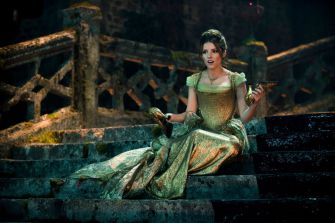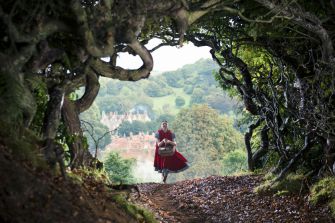As Cinderella runs from an immoral prince, Little Red Riding Hood skips towards her grandmother’s house daydreaming about the wolf, and Jack grows a beanstalk which nearly causes the complete destruction of an entire kingdom, audiences go “Into the Woods” along with revitalized Brothers Grimm characters to experience an entirely new side of Disney.
The movie “Into the Woods” is an adaptation of the original stage musical of the same name, written by James Lapine and composed and lyricized by Stephen Sondheim. The stage production is often revered as being one of the greatest musicals of all time. Though the original production premiered on Broadway in 1987, Sondheim and Lapine collaborated again on the film, as the screenplay is written by Lapine and Sondheim rewrote some of his original songs for the cinema.
In light of recent movie musicals which degrade the genre, such as “Mamma Mia!” and “The Sound of Music Live,” Disney’s recent adaptation of “Into the Woods” under the direction of Robert Marshall reinvigorates the movie musical for modern audiences while staying fairly true to the original stage production.

“Into the Woods” is a mashup of classic fairy tales. The story effectively strips away the fantastical facade of some of our favorite storybook characters and exposes the complex, self-aware and struggling human beings which the Brothers Grimm originally sought to depict in their writing. While the characters enter the woods driven by wishful thinking, they leave realizing that what they wished for wasn’t exactly what they wanted, and with the understanding that happily ever afters don’t always go as planned.
The central theme and tone of the musical is most accurately reflected in the song “No One Is Alone,” in which Cinderella and the Baker, played by Anna Kendrick and James Corden, comfort Little Red Riding Hood and Jack, played by Lilla Crawford and Daniel Huttlestone.
“No One Is Alone” is primarily about dealing with loss as well as the importance of bonding with and supporting others. It also arguably has one of the most beautiful melodies written for musical theater in the past century. Being the most simply shot scene in the movie, “No One Is Alone” does the original stage production the most justice by reflecting its intimate, raw, dark and complicated roots while set in a darkened wood, even though the lighter proceedings of the film do not adequately justify the intention behind the song.
The piece is supported by Sondheim’s intelligent lyrics and illustrious melodies, recorded with a luscious 65 piece orchestra. Sondheim’s work is notorious throughout the musical theater community as being some of the most difficult to perform vocally and emotionally, but also some of the most rewarding for actors to dive into.
Sondheim’s songs are typically viewed as scenes put to music, as they heighten complex relationships and conflicts when mere words can no longer fully express what a character is trying to say. This depth of Sondheim’s writing makes “Into the Woods” accessible to nearly all cinema audiences.
The cast took full advantage of the opportunity to work in the realm of Sondheim, and as an ensemble, delivered sublime heart wrenching performances. Unlike the recent unfaithful movie adaptation of the Broadway musical “Les Miserablés,” where actors with minimal to no Broadway experience were inclined to “talk sing” due to the film’s live recording experiment, “Into the Woods” utilized famous film and theater actors alike, all of whom were qualified to do their parts justice.
The most surprising performance was from Meryl Streep, who plays the Witch. Regardless of her indisputable acting talent, her subpar singing in the film “Mamma Mia!” made me question whether she would be able to tackle the Witch’s incredibly difficult vocal score. But I was proven wrong. Streep delivered a breathtaking performance. Her singing was incredibly diverse and fully resonant, releasing both a powerful belted sound and a beautiful vibrato. The combination of her seemingly newly developed singing voice along with her tour de force control of the character made Streep arguably one of the best Witch’s “Into the Woods” has ever known, possibly superseding the original Witch, Broadway legend Bernadette Peters.

While every other character experiences a complex and nuanced journey, Cinderella’s Prince, played by Chris Pine, is the ultimate antagonist of the “Into the Woods” message. Pine expertly depicts a stereotypical prince, and by being purposefully two-dimensional, reinforces the idea that charm doesn’t always equate with sincerity.
In an otherwise dark tale, Pine’s song “Agony,” a duet sung with Rapunzel’s Prince, played by Billy Magnussen, adds comic relief and quite possibly steals the show as the two melodramatically prance and splash through pristine waterfalls while dreaming of their maidens who are “just out of reach.”
A major breakout star in the film was Lilla Crawford, who played Little Red Riding Hood. Having performed the title role in Broadway’s 2012 revival of “Annie,” Crawford is Broadway’s latest child sweetheart. Crawford’s beautiful voice and sheer simplicity in her interpretation of Little Red harmonizes beautifully with her primary scene partner Johnny Depp, who plays the wolf. Though Crawford’s young age innately diminished some sexual innuendos in Little Red’s song “I Know Things Now,” it certainly did not supersede her overall performance.
While the musical theater community tends to be very protective of its original stage work, they have generally embraced this newest movie musical adaptation, despite complaints of “disneyfication”, a diminished message, and cutting certain songs like the Baker’s heartfelt “No More.”
Disney’s unwillingness to fully commit to the inherent darkness of the story resulted in the last third of the film to drag a bit, and certain songs like the Witch’s Lament and “No One is Alone” to feel unjustified and less impactful. However, while it is safe to say that another production company may have done the adaptation of “Into the Woods” more justice, Disney’s adaptation sufficiently tells the story, is expertly cast, beautifully staged, and is accessible to nearly all cinema audiences.






